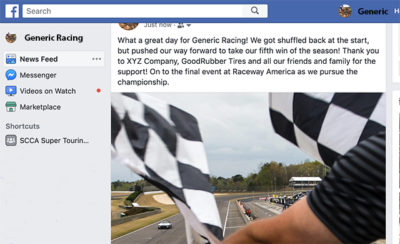Direct Communication through e-mail and social media can be very effective and, more importantly, shareable
In previous installments, we’ve discussed the tools a driver needs in order to receive press coverage, as well as where and how to get it. But there’s an often overlooked, but critical, component of public relations: direct communication, either through an e-mail newsletter, blog or social media.
“There might be such a thing as an effective one-pole tent, but for the most part, you need two poles for a tent, or maybe even three, to build the biggest funnel of communications coming from you and your racing,” opines Matt Cleary, principal of Sunday Group Management, which provides management and public relations services for drivers, teams and race series, including Idemitsu Mazda MX-5 Cup. “There’s no one magic method of communication; there’s no single solution. Perhaps you have a newsletter or press release distribution or a massive social media following; that’s great, but none of those work on their own as you need to have a diversity of ways of getting your message out, because there is a great diversity of ways that people get their news and updates.
“The other thing is to ask your audience, ‘How do you want to hear from me?’ Do you want me to put you on an e-mail list? Do you want to follow me on social media?’ If a driver has the opportunity to have one-on-one engagement like that, you can just ask them the question,” Cleary says. “That’s one area where social media is very strong – it gets immediate and direct feedback from the people who are following you.”
Some racing drivers have certainly mastered the art of social media. Sometimes that’s on their own, and sometimes that’s with the help of a savvy public relations person or social media specialist (yes, in 2019, that’s a real job).
James Hinchcliffe is one prime example; he’s developed a huge following on social media that extends well beyond the motorsports world thanks to his inspirational recovery from serious injury suffered at Indy, his “Dancing with the Stars” appearance, and his entertaining posts. Other drivers may wish to emulate that success, but they have to be honest with themselves as to whether they have the charisma and savvy to be like the Mayor of Hinchtown. Figure out how you want to portray yourself to the wider world and then develop a strategy.
“Before you decide you want to use this as an avenue to promote your racing, much like you lay out a race program, you need to lay out what your strategy is,” says Efrain Olivares, the Motorsports PR representative for Mazda North American Operations. “What is it you intend to do from a career standpoint? You need to consider how social media can help that.”
Olivares also notes that Mazda Motorsports uses each of the big three social media platforms – Facebook, Twitter and Instagram – differently and has separate strategies for each.
One of the biggest benefits of e-mail and social media is the ability to instantly share. You’ve had some racing success and you share it with sponsors, friends and potential sponsors. In turn, they might share it as well, and your success instantly spreads to hundreds – maybe thousands – of potential supporters and sponsors. Cool photos (make sure you have the rights to share the photo) make sharing exponentially more likely. And the more platforms you use, and the more stuff you share – as long as it’s interesting and relevant – the more likely that is to happen.
“You’ve got to have multiple spinning plates,” says Cleary, referring to an impressive circus act. “You don’t know what e-mail is going to get forwarded to someone who could become a supporter or someone else who is interested. You don’t know who is going to retweet you. So, keeping a consistent message, across multiple platforms, gives you the best chance of success.”
But therein lies one of the pitfalls of social media. “Social media is a double-edged sword because it’s so easy to broadcast whatever silly thing, or whatever serious thought, is in your head,” explains Olivares, who handles public relations for Mazda Team Joest in the IMSA WeatherTech SportsCar Championship. “Aside from whether or not what you’re saying is any good, someone will remember it. There’s always going to be a record of it, so own your mistakes when you have to.
“The ability to broadcast comes with the ability for people to broadcast to you when you make a mistake,” Olivares points out. “Much like with how someone should behave when dealing with media and sponsors, the aim is to be forthright and likable. Look at what other athletes are doing, and what mistakes they have made, and learn from them. Take note of what makes an impression on you, but also keep in mind that you can’t be anyone other than yourself.”
There are great benefits to social media and the wider world of media coverage. But there are pitfalls – some of which we’ve already addressed. In the next installment of our series on public relations, we’ll touch on what to avoid.


 ACCESSIBILITY
ACCESSIBILITY